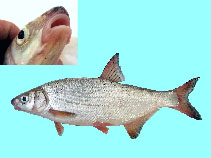Upload your photos and videos
Pictures | Google imageVimba vimba
Picture by Otel, V.
Pictures | Google imageVimba vimba
Picture by Otel, V.
Slovenia country information
Common names:
Ogrica
Occurrence: native
Salinity: freshwater
Abundance: | Ref:
Importance: | Ref:
Aquaculture: | Ref:
Regulations: | Ref:
Uses: no uses
Comments: Known from Danube drainage (Ref. 59043). Population has declined due to river regulation. Conservation measures include artificial propagation (Ref. 90061). Status of threat: endangered (Ref. 90061).
National Checklist:
Country Information: https://www.cia.gov/library/publications/resources/the-world-factbook/geos/si.html
National Fisheries Authority:
Occurrences: Occurrences Point map
Main Ref: Povz, M., 1996
National Database:
Occurrence: native
Salinity: freshwater
Abundance: | Ref:
Importance: | Ref:
Aquaculture: | Ref:
Regulations: | Ref:
Uses: no uses
Comments: Known from Danube drainage (Ref. 59043). Population has declined due to river regulation. Conservation measures include artificial propagation (Ref. 90061). Status of threat: endangered (Ref. 90061).
National Checklist:
Country Information: https://www.cia.gov/library/publications/resources/the-world-factbook/geos/si.html
National Fisheries Authority:
Occurrences: Occurrences Point map
Main Ref: Povz, M., 1996
National Database:
Common names from other countries
Classification / Names Common names | Synonyms | Catalog of Fishes(genus, species) | ITIS | CoL | WoRMS | Cloffa
Teleostei (teleosts) > Cypriniformes (Carps) > Leuciscidae (Minnows) > Leuciscinae
More on author: Linnaeus.
More on author: Linnaeus.
Environment: milieu / climate zone / depth range / distribution range Ecology
Freshwater; brackish; benthopelagic; anadromous (Ref. 51243). Subtropical; 10°C - 20°C (Ref. 2059); 64°N - 35°N, 12°E - 53°E
Distribution Countries | FAO areas | Ecosystems | Occurrences | Point map | Introductions | Faunafri
Eurasia: Caspian, Black, Marmara and Baltic Sea basins (Sweden and Finland north to 63°N), North Sea basin from Elbe to Ems drainages. In Anatolia: in Marmara basin, south to Great Menderes and Lake Egridir and east to Kızılırmak drainage. Absent between Kızılırmak and Çoruh drainages. Extirpated in Crimea. Introduced in Rhine.
Size / Weight / Age
Maturity: Lm ? range ? - ? cm
Max length : 50.0 cm TL male/unsexed; (Ref. 556); common length : 20.0 cm TL male/unsexed; (Ref. 556); max. published weight: 1.4 kg (Ref. 35541); max. reported age: 15 years (Ref. 59043)
Max length : 50.0 cm TL male/unsexed; (Ref. 556); common length : 20.0 cm TL male/unsexed; (Ref. 556); max. published weight: 1.4 kg (Ref. 35541); max. reported age: 15 years (Ref. 59043)
Short description Identification keys | Morphology | Morphometrics
Dorsal spines (total): 3; Dorsal soft rays (total): 8 - 9; Anal spines: 3; Anal soft rays: 16 - 22. Diagnosed from its congeners in Europe by the following characters: anal fin with 16-21½ branched rays; back keeled behind dorsal base; in spawning season, males blackish brown with orange cheek and sometimes belly (Ref. 59043). Caudal fin with 19 soft rays. Scalar formula: 49-64, 6-10 (Ref. 40476).
Inhabits brackish estuaries, large to medium rivers and some large subalpine lakes. Sedentary populations inhabit even in small rivers or barbel zone. Feeds mainly on small molluscs and insect larvae. Breeds in riffles in shallow, fast-flowing streams and rivers on gravel. Semi-anadromous populations forage in freshened parts of sea and migrate for long distances to spawn. Lacustrine populations move to fast-flowing tributaries. Spent adults return to foraging habitats (Ref. 59043). Threatened from its range due to water obstruction (Ref. 26100).
Life cycle and mating behavior Maturity | Reproduction | Spawning | Eggs | Fecundity | Larvae
Produces 15,000-20,000 eggs at the age of 6-7 years (Ref. 12259). Spawns for several years. Semi-anadromous populations undertake long distance spawning migrations while lacustrine populations migrate to fast-flowing tributaries. In Dniepr and Kuban, migration starts in September, decreases in winter and resumes in March-May (Ref. 59043).
Main reference
Upload your references | References | Coordinator | Collaborators
Kottelat, M. and J. Freyhof, 2007. Handbook of European freshwater fishes. Publications Kottelat, Cornol and Freyhof, Berlin. 646 pp. (Ref. 59043)
Threat to humans
Harmless
Human uses
Fisheries: minor commercial; aquaculture: commercial; gamefish: yes
FAO(Fisheries: production; publication : search) | FishSource |
More information
Population dynamics
Growth parameters
Max. ages / sizes
Length-weight rel.
Length-length rel.
Length-frequencies
Mass conversion
Recruitment
Abundance
Growth parameters
Max. ages / sizes
Length-weight rel.
Length-length rel.
Length-frequencies
Mass conversion
Recruitment
Abundance
Life cycle
Reproduction
Maturity
Fecundity
Spawning
Spawning aggregations
Eggs
Egg development
Larvae
Larval dynamics
Reproduction
Maturity
Fecundity
Spawning
Spawning aggregations
Eggs
Egg development
Larvae
Larval dynamics
Anatomy
Gill area
Brain
Otolith
Gill area
Brain
Otolith
Physiology
Body composition
Nutrients
Oxygen consumption
Swimming type
Swimming speed
Visual pigments
Fish sound
Diseases & Parasites
Toxicity (LC50s)
Body composition
Nutrients
Oxygen consumption
Swimming type
Swimming speed
Visual pigments
Fish sound
Diseases & Parasites
Toxicity (LC50s)
Human related
Aquaculture systems
Aquaculture profiles
Strains
Ciguatera cases
Stamps, coins, misc.
Aquaculture systems
Aquaculture profiles
Strains
Ciguatera cases
Stamps, coins, misc.
Tools
Bio-Quiz | E-book | Field guide | Length-frequency wizard | Life-history tool | Point map | Classification Tree
| Catch-MSY |
Special reports
Download XML
Internet sources
Alien/Invasive Species database | Aquatic Commons | BHL | Cloffa | Websites from users | Check FishWatcher | CISTI | Catalog of Fishes(genus, species) | DiscoverLife | ECOTOX | Faunafri | Fishtrace | GenBank(genome, nucleotide) | GloBI | GOBASE | | Google Books | Google Scholar | Google | IGFA World Record | MitoFish | National databases | Otolith Atlas of Taiwan Fishes | Public aquariums | PubMed | Reef Life Survey | Scirus | SeaLifeBase | Tree of Life | Wikipedia(Go, Search) | World Records Freshwater Fishing | Zoological Record
Estimates based on models
Phylogenetic diversity index (Ref. 82804): PD50 = 0.5625 [Uniqueness, from 0.5 = low to 2.0 = high].
Bayesian length-weight: a=0.00724 (0.00659 - 0.00796), b=3.14 (3.11 - 3.17), in cm Total Length, based on LWR estimates for this species (Ref. 93245).
Trophic level (Ref. 69278): 3.3 ±0.1 se; based on diet studies.
Resilience (Ref. 120179): Low, minimum population doubling time 4.5 - 14 years (K=0.22; tm=3; tmax=15).
Fishing Vulnerability (Ref. 59153): Moderate vulnerability (37 of 100).




